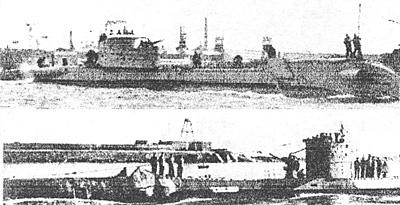 UD-3 and UD-4 (the former Dutch submarines O-25 and 0-26 respectively) were scuttled at the end of the war at Kiel, but UD-5 (the former Dutch submarine 0-27) was returned to the Dutch in 1946. Several submarines were transferred from the Royal Navy to the Dutch Navy later on during the war.
UD-3 and UD-4 (the former Dutch submarines O-25 and 0-26 respectively) were scuttled at the end of the war at Kiel, but UD-5 (the former Dutch submarine 0-27) was returned to the Dutch in 1946. Several submarines were transferred from the Royal Navy to the Dutch Navy later on during the war.
Top: TIGGERHAAI and Bottom: DOLFIJN
The British S-Class submarine STURGEON was renamed ZEEHOND in 1943 when transferred to the Dutch Navy, and the two T-Class submarines HMS TALENT and HMS TARN were renamed ZWAARDVISCH and TIGGERHAAI (photo) respectively and were transferred upon completion in 1943 and 1944 respectively. Both served in the Far East. The U-Class HMS P-47 was renamed DOLFIJN (photo) and transferred upon completion in 1942.
EDITORíS NOTE - During WW II, UD-3 sank the 5,041 ton Nowegian ship INDRA; and UD-5 sank the 7,628 ton British ship PRIMROSE HILL.
Both ZWAARDiVSCH and DOLFIJN served in European waters. The Dutch submarines were the most active of allied nations except the Americans when they entered the war. The exploits of the Dutch submarines are mentioned through this piece.
Norway has a coastline of two thousand miles from headland to headland. If the deep indentations of the fjords that seam her countryside be taken in, the coasts of the leads and larger islands be reckoned in as well, twelve thousand miles of tidemark fringe her shores. To guard that coast, to protect her merchant fleet - the fourth largest in the world's ocean-going fleets, five million tons of ships - she had a navy of two coast defense battleships, almost forty year of age; seven light destroyers; nine small submarines and forty small craft from sloops and torpedo boats to minelayers and minesweepers. To these, for the necessities of the neutrality patrol, she had added about sixty auxiliary vessels - fishery protection ships, armed trawlers and steam whalers.
The nine submarines of the Norwegian Navy were A-2, A-3, A-4, B-1, B-2, B-3, B-4, B-5 and B-6.
The A-Class submarines were all launched in 1913. They were very small boats of 250 - 340 tons with three torpedo tubes and a compliment of only fifteen men.
The B-Class were all launched between 1922 and 1929. They were also small boats of 420 - 550 tons with four torpedo tubes and a compliment of twenty-three men.
When Germany invaded Norway in the Oslofjord, the great indentation which constitutes the "V" of the Skagerrak and the Kattegat and thrusts seventy miles into the very heart of Norway, there were a handful of ships including four submarines A-2, A-3 and A-4 at Tonsberg on the west side of the fjord, and B-4 refitting at Horton. There could have been no sea battle in the Oslofjord even had Norway time to organize her whole defenses. There could have been only a sea massacre
To prevent their capture by the Germans, the crews of three of these submarines scuttled their boats.....B-4 on 20 April, A-3 and A-4 on 16 April. A-2 was captured on 9 April but was retaken by the Norwegians and abandoned, badly damaged, at their submarine base on the 12th.
Of the remaining five Norwegian submarines, only B-1 escaped to Britain in June 1940 and joined the 7th Submarine Flotilla as an ASDIC training and target boat until she was paid off (decommissioned) 24 April 1944.
B-2 and B-4 were captured by the Germans but due to their poor condition, were never used by them.
The Submarines B-5 and B-6 were also captured by the Germans on I 1 April and 18 May respectively and put into service as the German UC-1 and UC-2 until being stricken. B-5 was stricken in 1942 and B-6 in 1944.
Back to KTB # 152 Table of Contents
Back to KTB List of Issues
Back to MagWeb Master Magazine List
© Copyright 2001 by Harry Cooper, Sharkhunters International, Inc.
This article appears in MagWeb.com (Magazine Web) on the Internet World Wide Web. Other articles from military history and related magazines are available at http://www.magweb.com
Join Sharkhunters International, Inc.: PO Box 1539, Hernando, FL 34442, ph: 352-637-2917, fax: 352-637-6289, www.sharkhunters.com
